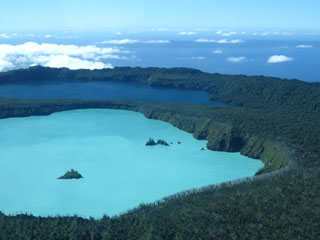Report on Ambae (Vanuatu) — 5 May-11 May 2010
Smithsonian Institution / US Geological Survey
Weekly Volcanic Activity Report, 5 May-11 May 2010
Managing Editor: Sally Sennert.
Please cite this report as:
Global Volcanism Program, 2010. Report on Ambae (Vanuatu) (Sennert, S, ed.). Weekly Volcanic Activity Report, 5 May-11 May 2010. Smithsonian Institution and US Geological Survey.
Ambae
Vanuatu
15.389°S, 167.835°E; summit elev. 1496 m
All times are local (unless otherwise noted)
On 11 May the Vanuatu Geohazards Observatory noted that there had been recent increases in activity from Aoba, starting with reports that local villagers saw a plume over the island in December 2009. Fluctuating gas emissions seen in satellite imagery were also noted at that time. Satellite imagery on 11 April revealed that sulfur dioxide emissions increased to a rate of more than 3,000 tons/day. Scientists flew over Aoba and confirmed increased gas emissions. They also noted two fumarolic zones in the SE part of Lake Manaro that were surrounded by discolored water. The Vanuatu Volcano Alert Level (VVAL) remained at 1 (on a scale of 0-4).
Geological Summary. The island of Ambae, also known as Aoba, is a massive 2,500 km3 basaltic shield that is the most voluminous volcano of the New Hebrides archipelago. A pronounced NE-SW-trending rift zone with numerous scoria cones gives the 16 x 38 km island an elongated form. A broad pyroclastic cone containing three crater lakes (Manaro Ngoru, Voui, and Manaro Lakua) is located at the summit within the youngest of at least two nested calderas, the largest of which is 6 km in diameter. That large central edifice is also called Manaro Voui or Lombenben volcano. Post-caldera explosive eruptions formed the summit craters about 360 years ago. A tuff cone was constructed within Lake Voui (or Vui) about 60 years later. The latest known flank eruption, about 300 years ago, destroyed the population of the Nduindui area near the western coast.
Source: Vanuatu Meteorology and Geohazards Department (VMGD)

